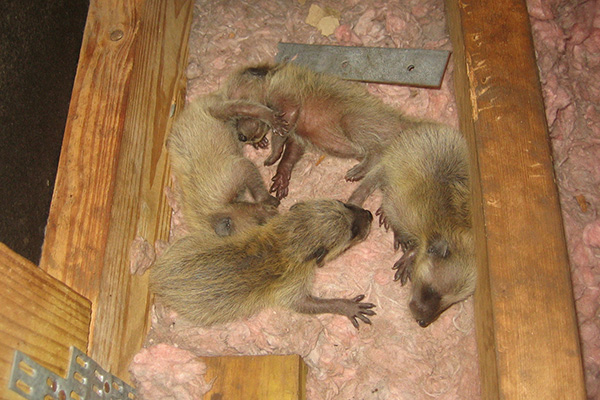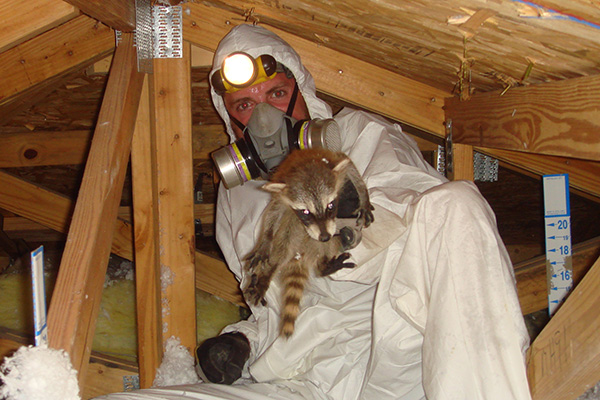- info@animalatticpest.com
- Call - we service 300 locations

Raccoon Nest in Attic - Nest of Baby Raccoons
Is there a nest of baby raccoons? Yes. Pretty much every time raccoons are in the attic, it's a single female who has a litter of young. She finds her way into the attic, usually in the spring, from March-May, and gives birth to 3-5 young. They can walk around at about 6 weeks of age, but they take a while to mature, and the mother keeps them in the attic for up to 8 months while they grow and she teaches them how to live. You must be aware of the young. If you remove just the female raccoon while the litter of young is less than six weeks old, you will have a problem. The young may scratch or claw, maybe through the ceiling, or they may starve to death and rot and stink. It is very inhumane to remove a nursing female raccoon and leave the young behind. To find the nest, search all around the attic. Look for the areas with heavy droppings, and trails in the insulation. You may have to dig around a bit. The trick I use most often is that I sit in the dark attic, perfectly still, for up to a half hour. At some point, the young will make some vocal chattering, and you'll be able to pinpoint their location. The nest is usually at the edge of the attic, near the eaves, or down in the eave itself. Remove the nest by hand, and then relocate the baby raccoons with the mother, or bring them to a wildlife rehabber. You can also, alternatively, wait until they are about 12 weeks old, at which time they will start to leave the attic at nights with their mother, on foraging trips. You can catch them all in cage traps at this time, or you can seal shut the entry hole once you know they are all out for sure. If you want to hire someone to do this, read more about how much does raccoon removal cost.
Raccoon Nest in Attic - Nest of Baby Raccoons
Nest of Baby Raccoons in Attic
A nest of 4-week old raccoons in the insulation of an attic. If you trap and remove just the mom, these animals will starve to death in your home.
2-Week Old Baby Raccoons
Here's a photo of very small babies. They are too young to adequately crawl. Gently remove them (look out for momma raccoon!) and use them to catch her.
6-Week Olds by the Edge of the Roof
Raccoons this size can run around if they want, which can make capture difficult, so you must do it swiftly. Be sure to care for these cute critters!
Information About Nest of Baby Raccoons in the Attic
Raccoon Nest In Attic – Nest Of Baby Raccoons
In almost every case where there is a raccoon in your attic, you are likely to have a nest of baby raccoons as well. This is particularly true if you happen to notice the raccoons during the nesting season. Raccoons are typically born in March and then become noticeable during April, but this will vary depending on the area of the country you live in. Those in warmer climates, for example, may have a nest of baby raccoons at nearly any time of the year.
Why Raccoons Nest In Attic
It sometimes helps to understand why the raccoons are nesting in your attic as it gives you an idea of what they are feeling and helps you find an appropriate location to relocate them. Raccoon mothers need a secure area for nesting and attics provide just that. Keep in mind that if a male raccoon comes across her nest and isn’t the father, he will kill her babies so he can mate with her instead. Because of this, hiding her young is crucial for mother raccoons. When you come across the raccoon nest in your attic, you may notice nearly any materials. Opportunistic raccoons may use pieces of your insulation, leaving it shredded in a pile that they can burrow into. You may also find some hay or long grasses, although the raccoon is more likely to use whatever nesting material is handy in your attic, whether that is insulation or something else.
And don't forget, they love to live in chimneys too: it's like a big hollow tree. Read about How To Get Raccoons Out Of A Chimney.
Trapping Is Not An Option
The bad news about having baby raccoons in your attic is that you can’t just trap and remove them like you would with their adult counterparts. Trapping only works if animals are larger and old enough to move around by themselves. It is also important that you don’t trap babies that could be harmed by the trap. If you were to set up a trap to catch the raccoons, you would only get the mother, leaving the babies to starve. Because of this, you need to use a combination of methods.
Removal By Hand
The only effective way to remove a nest of baby raccoons is to actually go into the attic and physically grab the baby raccoons one by one to remove them. If the mother is out getting food, you could get the babies at this point. You can even use them to get the mother to entire the cage trap. An alternative is to set up a trap for the mother and as soon as you catch her, grab the babies and move them all together. Regardless of the order you do things in, you need to minimize the time the babies and mother are apart and ensure the mother knows where her kits are.
How Do You Know There Are Babies?
The only way to be positive that there are baby raccoons in your attic is to see or hear them, but it is a safe assumption that there will be some. After all, the majority of raccoons that go into a building will be mothers who are looking for a safe, warm place to create a nest and have their babies. You can confirm that the raccoon had babies by checking if its nipples are protruding, although this requires excellent eyesight and/or getting very close to the mother raccoon.
Finding The Nest
Since there is likely to be a nest of baby raccoons in your attic if any of these animals are present, you will need to find the nest so you can take care of them. If you don’t see it at a quick glance in your attic, then wait until nighttime and listen, letting the sounds guide you to the nest. You can also look for raccoon droppings to help you find the nest. While these animals will leave waste everywhere, there will be a larger amount of it closer to the nest. Unfortunately, nests are commonly had to reach, tucked into eaves or down inside the wall.
Consult A Professional
While consulting an expert is typically helpful for removing any animals in your attic, this is particularly true of baby raccoons. The nest of babies makes the entire process more complicated, particularly if the mother is present and becomes aggressively protective of her babies. Professionals know how to read the warning signs that the mother gives off so they can back away and avoid injury. They will also know the best method of catching the mother and physically removing the babies as well as where to relocate the animal to. After all, some areas of the country will have restrictions as to where you can release raccoons and other wildlife and may even require a license or something similar to trap these animals. Wildlife professionals will know local regulations and be able to easily comply with them.
The Bottom Line
How to remove a raccoon nest in the attic - it's hard work. You have to either search for it and remove the nest by hand, and then relocate the baby raccoons with the mother, or bring them to a wildlife rehabber. Or you have to wait 12 weeks after birth for them to be big enough to go outside and into your traps. Don't leave the nest of helpless young behind in your attic! They can scratch and claw, and if they don't get out, they will starve and die and decompose and cause an odor problem.




